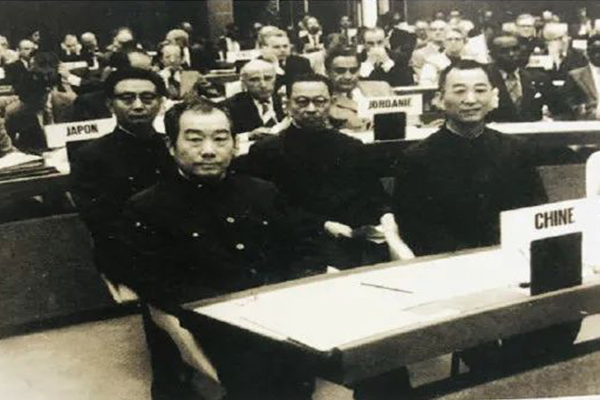2022-06-20Source: China Daily
Aligning a Beautiful China with global partners can help avert climate catastrophe
Exactly 50 years ago in Stockholm, when the Swedish government received a Chinese delegation participating in the first United Nations Conference on the Human Environment, neither side realized the significance of this event would go far beyond that it was China's first official UN-sponsored activity following its historic return to the UN family in 1971.

China immediately embraced the still nascent concept of environmental protection and inaugurated a half-century sustainability journey that no one could have envisioned back then. Although a latecomer that is still going through its uniquely fast and condensed industrialization process, China has demonstrated remarkable willingness not only to learn, but also to cooperate with the international community on finding solutions to all daunting environmental threats.
Actually, China was so open and creative that in 1992 it established a dedicated cooperation mechanism, the China Council for International Cooperation on the Environment and Development. The CCICED is composed of experts working on almost all related topics in the field, 50 percent of them are Chinese experts and 50 percent foreign. Two days ago, the CCICED celebrated its 30th anniversary, which in itself testifies to the progress that China has made. One everlasting theme that the CCICED has witnessed is that while the green agenda has steadfastly become the central theme of development, China continues to make progress in economic and social development and poverty alleviation, demonstrating that social, economic and environmental progress can go hand-in-hand.

The year 2050 has emerged as the critical milestone year for the global community beyond the 2030 target year for realizing the 17 Sustainable Development Goals of the UN. The year 2050 is significant, because it is an international scientific consensus that, in order to prevent the worst climate damages, global net human-caused emissions of carbon dioxide need to reach net zero around 2050. By that year, signatories of the Paris Agreement are required to plan their mid-century carbon control strategies.
Today, 132 countries have pledged to achieve carbon neutrality by 2050 and many others are joining them on their way. Long-term strategies have a critical role to play in this transition because only through setting up both bold and collective goals and then back-casting and extrapolating from the long-term goal can humanity achieve the necessary balance between development and natural resources.
Coincidentally, 2049 is the 100th anniversary of the founding of the People's Republic of China, which is the year set for the country to have achieved its goal of becoming a modern prosperous country with a harmonious relationship between man and nature. One of the most important aspects of this goal is building an ecological civilization, the concept that China has been pioneering and has included in its Constitution. With a strong central planning mechanism and a track record of achieving its environmental targets during its five-year plans, China has the unique experience and capabilities to achieve this necessary balance domestically, demonstrating to the world how important it is to equip ambitions with step-by-step actions.
Despite all the turbulence and chaos, the 21st century will undoubtedly be recorded in modern history as the "green century", not only because environmental awareness planted in the last century has now come to fruition, but also because the health and well-being of people are more keenly threatened by the "triple planetary crises" of climate change, nature and biodiversity loss, and pollution. The situation has been made even worse in recent years by the devastating COVID-19 pandemic and by geopolitical tensions that are slowing global cooperation. Deep decarbonization goals can only be achieved through the sharing of resources, knowledge and experiences and can only be achieved when a broader constellation of countries, cities and companies are engaged.
China has shown itself willing to act to address these triple planetary crises and is a convincing contributor, based not only on what it has learned and practiced in the past 50 years, but also on the green pathway the country has pioneered for itself toward mid-century. Through cooperation with the European Union and the United States, China has established the world's largest carbon emissions trading system, which now covers the power sector, representing more than 40 percent of national carbon dioxide emissions.
While much of the world has seen a rise in pollution in recent years, global pollution has decreased due entirely to China's impact since 2013. Without China's significant decline in pollution, global average pollution would have increased in that time. Through hosting the COP 15, China has strengthened its entire ecological governance and it has now pledged to plant and cultivate 70 billion trees by 2030.
With China's influence increasingly felt in the global arena, China does not hesitate to supply green goods to the global society and shoulder its differentiated responsibilities. With the launch of the Belt and Road Initiative International Green Development Coalition, China is applying what it has learned from the CCICED through the BRIGC to the countries that it has policy, infrastructure, trade, financial and cultural relationships with and together they are exploring new ways for China's learnings and experiences to spur and accelerate coupled climate and economic progress in partner countries. One groundbreaking effort of this is China's announcement of stopping building coal-fired power plants in Belt and Road countries and endeavoring to help other countries build green and low-carbon energy systems.

As a good participant and contributor to the global sustainability agenda, it is now the time for China to be more active and become a torchbearer in the global green agenda. With a production capacity of 80 percent of global solar PVs and 70 percent of the global battery production, China should no doubt uphold the global drive toward green and low carbon energy. What the world does this decade will dictate whether the global goal of limiting global warming to 1.5 C-and thus avoid the worst impacts-is within reach. The world needs China to take a lead role in delivering on that promise. One way China can do that is through a modernization vision for a "Beautiful China "by 2035 that links ambitious climate targets with economic and social development goals, while aligning global partners on comparable targets within the same time frame.
The author is the executive director of the BRI Green Development Institute, Zhang Jianyu.
Contact Us:
E-mail:secretariat@cciced.net
Address:5 Houyingfang Hutong,Xicheng District,Beijing 100035 P.R.Chinazip code:100035
Copyright © 2020 Secretariat of China Council for International Cooperation on Environment and Development. All Rights Reserved. Presented by China Daily.
